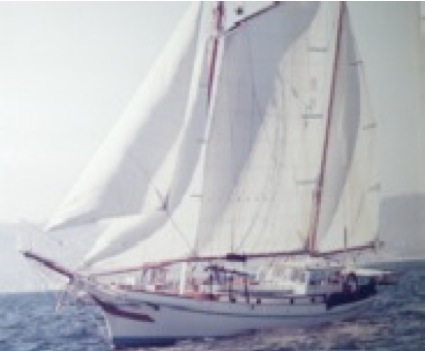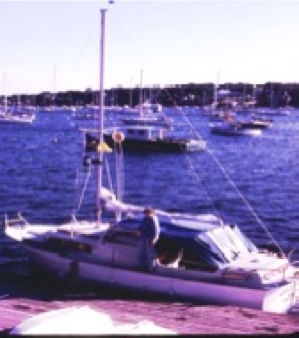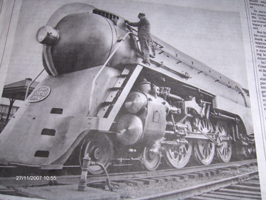Assembling a coherent life story,
and a possible genetic factor
|
Sea Dragon in Santa Monica Bay, 1982 During the years since I began teaching and directing a clinic at UCLA, I balanced out my indoor days with life as an enthusiastic weekend amateur mariner. We had purchased our new 36-foot Sea Witch class all-teak sailing ketch in 1960, and named her the Sea Dragon in part because she was built in Hong Kong. Apart from her husky English Ford tractor diesel and modern electronics, she was distinctive in that, with her jaunty long bowsprit, tarred lanyards and deadeyes, stern mounted skiff, and gaff mainsail, she was a smaller replica of the coastal vessels that plied the Maine coast and other American and Canadian waters in the early and middle 19th Century. Although beamy and sturdy, the genius of her design, exemplified in her double-ended waterline, allowed her to slip through any waters with relative ease. We made a sailing passage from Los Angeles to Honolulu in 1966 with my two children, my brother Bernard, now a distinguished and talented analyst and teacher, and two other teenage crewmen. A few years later, my wife Bea and I voyaged from New York to Bar Harbor, Maine in a smaller vessel. I love Maine not just for the lobsters but chiefly because of its beautiful sailing waters and strong maritime ambience. The names of places in coastal Maine are redolent of its early sailing ship history: Eggemoggin Reach, Thread of Life Passage, Pulpit Harbor, Bar Harbor, Christmas Cove, Rockport, Blue Hill Bay, Monhegan Island, Somes Sound (the only true fjord in the US coastlines).
Hudson-type locomotive for 20th Century Limited, Harmon, NY 1933 (New York Times advertisement) One loop goes way back to my childhood in New York. I loved riding in subway trains, especially those in Brooklyn that emerged from under the streets and ran in open concrete troughs or on elevated tracks. I subscribed to railroading pulp magazines, played with toy Lionel trains, and enjoyed traveling to relatives in New Jersey, which necessitated taking a ferry across the Hudson and then boarding a Jersey Central train pulled by a steam locomotive. Steam locomotives showed their mechanical workings by the eccentric and rotary movements of their pushrods and large drive wheels, and by the rhythmic chuffing of their exhausts. And, when not at work, they seemed very alive with their impatient puffing and sighing. This is the experiential background for my first journalistic assignment at Erasmus Hall High School, leading to my first publication, when I was fourteen. We had been asked at our literary magazine whom we wanted to interview, and I volunteered to see the engineer of the 20th Century Limited, then the fastest passenger train from New York to Chicago. Our faculty supervisor obtained permission from the New York Central Railroad for me to go to the yard in Harmon, about 40 miles north of the city, where the electric locomotive pulling the train from Grand Central station was exchanged for the panting stainless steel Art Moderne behemoth, seeming to paw the tracks impatiently while awaiting its wailing banshee dash to the Windy City. I interviewed the kind and patient Mr. Hugh Gaffney in his cab, and wrote the article on the way back down the Hudson River valley to Grand Central. Another illustration: during my sophomore year at NYU medical school I purchased and rode a surplus NYPD Indian motorcycle, with its Harley-ish chugging, and on one occasion took along three classmates on a Belt Parkway ride in Brooklyn. This was clearly illegal and arguably unsafe. It was probably our army uniforms (we were trading Army and Navy support of our medical education for "paybacks" as military doctors in what became the Korean War) that immunized us from a traffic ticket. One of the aims of the psychoanalytic process is the co-construction of a valid and coherent life narrative for the patient. Since the "relational turn" in psychoanalysis of the past twenty years, we have recognized the irreducible two-person nature of this type of psychotherapy. As a result, many therapists find themselves adjusting their own life narratives in the course of a professional career working with their patients. Only during the past few years has a coherent lifetime narrative begun to emerge for me. This perspective stems from findings in behavior genetics first reported in Los Angeles by the British analyst and UCL Professor Peter Fonagy. An example is the work of Dr. Ernest Noble and others at UCLA, and of others elsewhere, concerning the so-called 'migration gene', an allele-or variety-of a dopamine receptor gene (DRD4) which codes for restlessness, migration, novelty seeking and risk taking, among other effects that I won't mention here. I have had mixed results in getting laboratory confirmation of a “long” allele of DRD4 in my case: a repeat assay failed to confirm an initial reading confirming a 7-repeat allele in my genome. Since behavioral genetics is still in its infancy, there may yet be some kind of confirmation available – especially in the absence of clear psychopathological process. A secure genetic mooring could produce an amen for me by helping account for a variety of behaviors in addition to my seafaring - behaviors that my med school classmates thought peculiar if not pathological. In the ultimate absence of genetic confirmation, I elect to plead guilty to “peculiar” for now.
How do you suppose my psychoanalytic colleagues reacted to my return to motorcycling in the mid 1970's? It seemed at odds with the typical life trajectory of a co-professional. I began to feel there was something mentally wrong with me at that time - also possibly true of my brother Bernie (with whom I share half of my genome), of my analytic colleague, the late and sorely missed Mark Doran, and of several other psychiatrists who saddled up with their wives to join us in roaming Southern California and way beyond it in our little "Hell's Analysts" group. We weren't quite behaving as other people, including other analysts, expected. (Some East Coast analysts might have thought: "they are Southern Californians, so what can you really expect?") I also began to wonder about Bea, my wife, who headed up her department at Fresno County Hospital and had been a pioneer physical therapist as a first lieutenant in the Royal Canadian Army Medical Corps during WW II. She was water-skiing in irrigation canals with rough concrete walls pulled by an alongside car in Fresno when I met her. In our courtship we did a lot of hiking and skiing in the nearby Sierras, and she was an enthusiastic motorcycle companion during long trips to Canada and Mexico. The opposite of the caricatured air-head biking chick, she is an avid reader, art museum docent, and has a lively intellectual curiosity about my professional and academic interests as well as her own. We have traveled to all continents and oceans, preferring small ships, and places like the Faroe Islands, the Arctic icepack northeast of Greenland (is it still there?), Spitzbergen, Norway, Scotland, the little Cornish ports like Mousehole (pronounced "mussel"), the Tasman Sea, Antarctica, British Columbia, Newfoundland, French Polynesia, Brittany, Tunisia, and the Lipari Islands southwest of Pompey. Our ideal engine driven ship is less than ten thousand tons, like the Illyria, the Funchal, and the old P & O liner Chusan. We have little taste for the huge floating hotels now afloat though we have traveled in them. I'll never forget the scene from the public dock in Ketchikan, when the whole town seemed smaller than the Emerald Princess. But it was reassuring to be sitting at a leisurely lunch aboard Marco Polo, unperturbed in the troughs of 35-foot seas in clear weather just off Cape Horn. One of the adventures we had, in view of our love of classical music and of the sea, was the thrill of visiting the Isle of Staffa in the Scottish Inner Hebrides, where we spent an hour or so at Fingal's Cave, the inspiration for the Hebrides Overture by Mendelssohn. It has seemed like Bea may have a long allelic gene similar to mine. However, her assays, like mine, have had the same mixed results, and we intend to investigate the matter further. I prefer to believe that we are not crazy (in that way) after all, but just lucky to have found each other. She has been my healing angel through 3 recent major surgeries and a long recovery period since November of 2005. My family and my wonderful students, friends and patients have also contributed substantially to my convalescence. For the past eight or nine years, I have been doing voyages of research on the evolutionary roots of psychoanalytic theory and clinical practice, taking broader advantage of my continuing faculty membership at the UCLA medical school, and of many repeated contacts with graduate students and distinguished scholars from such neighboring disciplines as anthropology, evolutionary biology, behavior genetics, social psychology, comparative linguistics, cognitive neuroscience, economics and philosophy of mind. All explore the vagaries of human behavior. All are in a position to join hands with psychoanalysis to deepen our understandings of the inner sources of mankind's behavior. |



